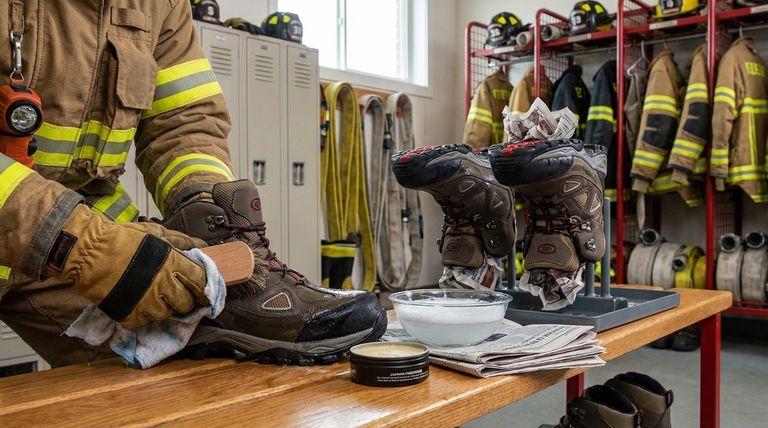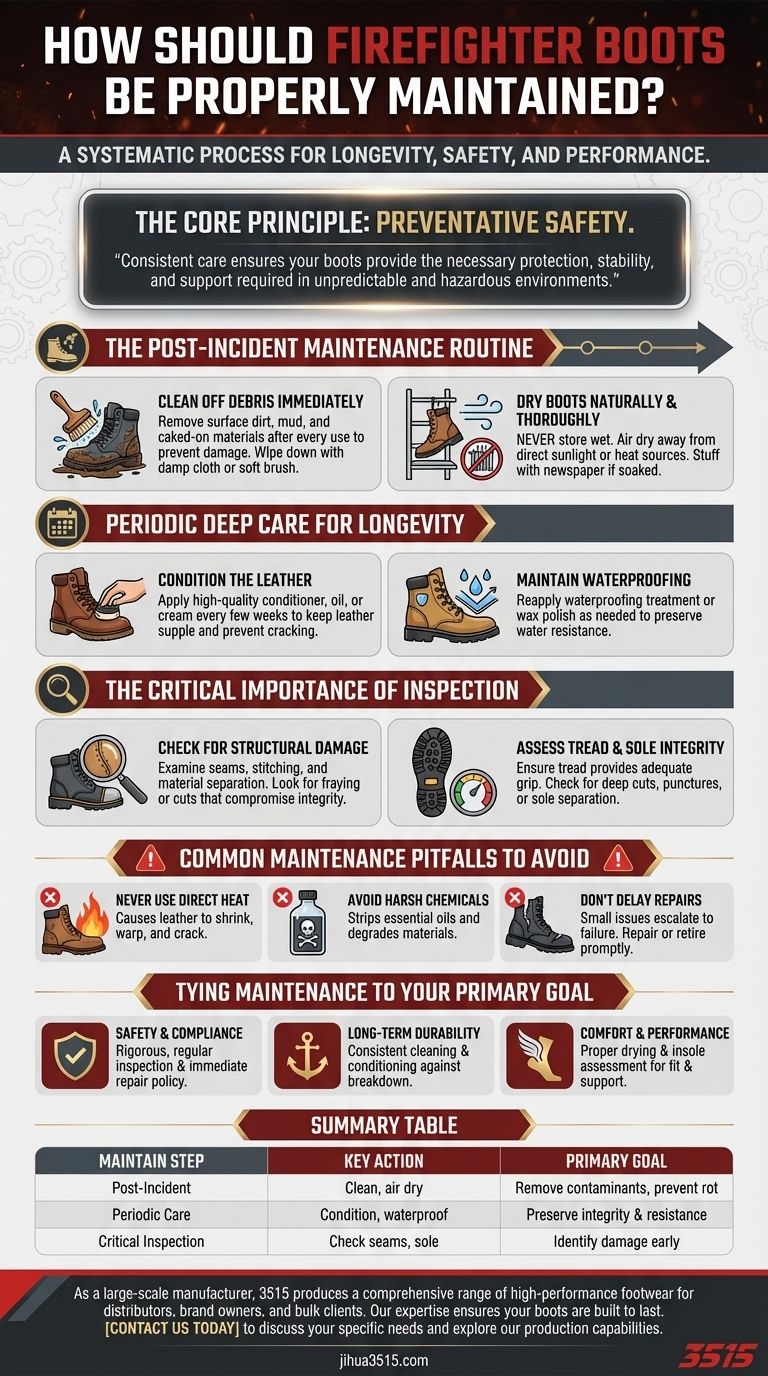Proper maintenance of firefighter boots is a systematic process of cleaning, drying, conditioning, and inspecting the gear after use. This routine is essential for removing contaminants, preserving the structural integrity of the materials, and ensuring the boots can perform their critical protective functions without fail.
The core principle of boot maintenance is not just about longevity; it is an act of preventative safety. Consistent care ensures your boots provide the necessary protection, stability, and support required in unpredictable and hazardous environments.

The Post-Incident Maintenance Routine
A firefighter's boots are exposed to extreme conditions and potential contaminants on every call. A consistent after-use routine is the first line of defense against premature wear and material degradation.
Clean Off Debris Immediately
After every use, remove all surface-level dirt, mud, and other debris. Caked-on materials can hide underlying damage and, if corrosive, can actively break down the boot's materials.
A simple wipe-down with a damp cloth or a soft brush is typically sufficient for routine cleaning. This prevents the buildup that leads to heavier, less comfortable boots.
Dry Boots Naturally and Thoroughly
Moisture is the enemy of both leather and synthetic materials, leading to rot, mildew, and loss of structural integrity. Never store boots wet.
Allow them to air dry naturally in a well-ventilated area away from direct sunlight or heat sources. If boots are soaked, you can stuff them with crumbled newspaper or use a dedicated boot dryer on a no-heat or low-heat setting.
Periodic Deep Care for Longevity
Beyond daily wipe-downs, a more thorough maintenance schedule preserves the core materials of your boots, especially the leather.
Condition the Leather
Leather is a natural material that requires moisture to remain supple and strong. Dry leather will crack, compromising the boot's protective barrier.
Apply a high-quality leather conditioner, oil, or cream every few weeks, or more often if your boots are frequently exposed to wet conditions. This replenishes the natural oils and prevents cracking.
Maintain Waterproofing
Even if your boots have a waterproof liner, maintaining the exterior's water resistance is crucial. This prevents the outer materials from becoming saturated, heavy, and cold.
Reapply a waterproofing treatment or wax polish as needed, following the manufacturer's specific instructions for your boot model.
The Critical Importance of Inspection
Visual and physical inspection is arguably the most important step in maintenance. This is where you identify minor issues before they become catastrophic failures during an emergency.
Check for Structural Damage
Carefully examine all seams, stitching, and points where different materials meet. Look for any signs of separation, fraying, or cuts that could compromise the boot's integrity.
Pay close attention to the areas around the steel toe and shank for any signs of damage or shifting.
Assess Tread and Sole Integrity
The sole provides your primary connection to the ground, offering stability and slip resistance. Ensure the tread is not worn down to a point where it can no longer provide adequate grip.
Check for any deep cuts, punctures, or signs that the sole is separating from the upper part of the boot.
Common Maintenance Pitfalls to Avoid
How you care for your boots is as important as whether you care for them. Avoiding common mistakes is crucial for preserving their lifespan and protective qualities.
Never Use Direct Heat to Dry
Applying high, direct heat from a radiator, fire, or blow dryer can cause leather to shrink, warp, and crack almost instantly. It can also damage the adhesives used to bond the sole.
Avoid Harsh Cleaning Chemicals
Stick to water, mild soap, and products specifically designed for boot care. Harsh chemical cleaners can strip essential oils from leather and degrade synthetic materials, causing irreparable damage.
Don't Delay Repairs or Replacement
Ignoring small tears or sole separation is a significant safety risk. A small issue can quickly escalate into a complete boot failure in the field.
Establish a clear threshold for when a boot should be professionally repaired versus when it must be retired from service.
Tying Maintenance to Your Primary Goal
Your approach to boot care should align with your most critical priorities as a firefighter, ensuring your gear is always ready for duty.
- If your primary focus is safety and compliance: Your most critical habits are rigorous, regular inspection and a strict policy for immediate repair or replacement.
- If your primary focus is long-term durability: Consistent cleaning and leather conditioning will provide the best defense against material breakdown.
- If your primary focus is comfort and performance: Prioritize proper drying techniques and frequent insole assessment to maintain fit, support, and agility.
Ultimately, treating your boot maintenance as part of your personal protective protocol ensures your most critical gear will never let you down.
Summary Table:
| Maintenance Step | Key Action | Primary Goal |
|---|---|---|
| Post-Incident | Clean debris, air dry naturally | Remove contaminants, prevent rot/mildew |
| Periodic Care | Condition leather, reapply waterproofing | Preserve material integrity & water resistance |
| Critical Inspection | Check seams, stitching, sole, and tread | Identify damage early to prevent field failure |
As a large-scale manufacturer, 3515 produces a comprehensive range of high-performance footwear for distributors, brand owners, and bulk clients. Our expertise in durable materials and construction ensures your firefighter boots are built to last. Let us help you equip your team with reliable gear. Contact us today to discuss your specific needs and explore our production capabilities.
Visual Guide

Related Products
- Safety Footwear Wholesale Manufacturer for Custom OEM/ODM Production
- High Performance Fire-Retardant Waterproof Safety Boots
- Premium Flame-Retardant Waterproof Safety Boots and Shoes
- Premium High-Cut Waterproof Safety Boots Manufacturing & Wholesale Solutions
- Wholesale Safety Footwear Manufacturer for Bulk & Custom OEM Orders
People Also Ask
- How long can you wear safety boots? The Lifespan is Determined by Wear, Not Time
- What are the differences between steel toe, composite toe, and alloy toe Wellington boots? Choose the Right Safety Toe for Your Job
- What are OSHA approved shoes? Understanding the Correct Standards for Workplace Safety
- What do heavy duty boots do? Protect Your Feet in Demanding Work Environments
- How do safety shoes contribute to cost savings for companies? A Strategic Investment in Risk and Cost Management



















